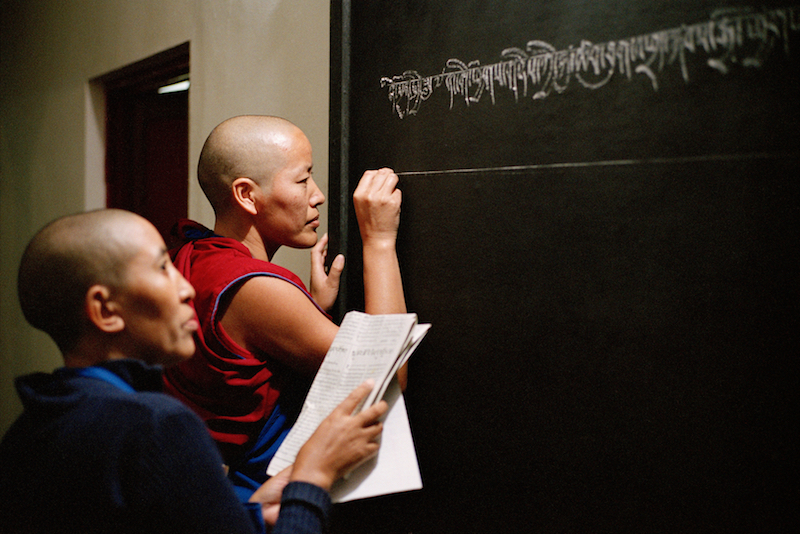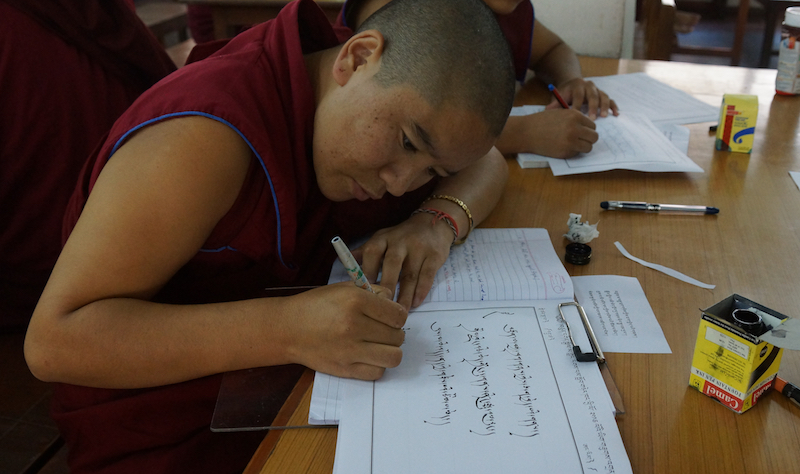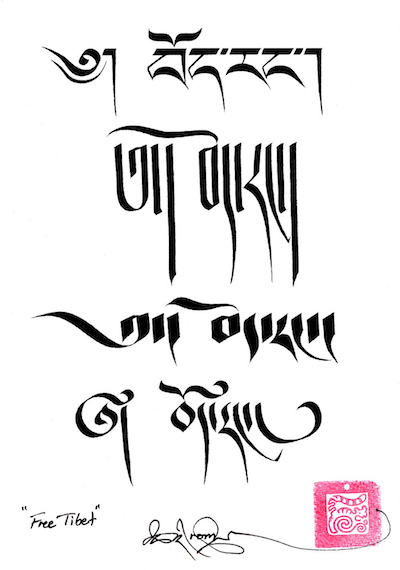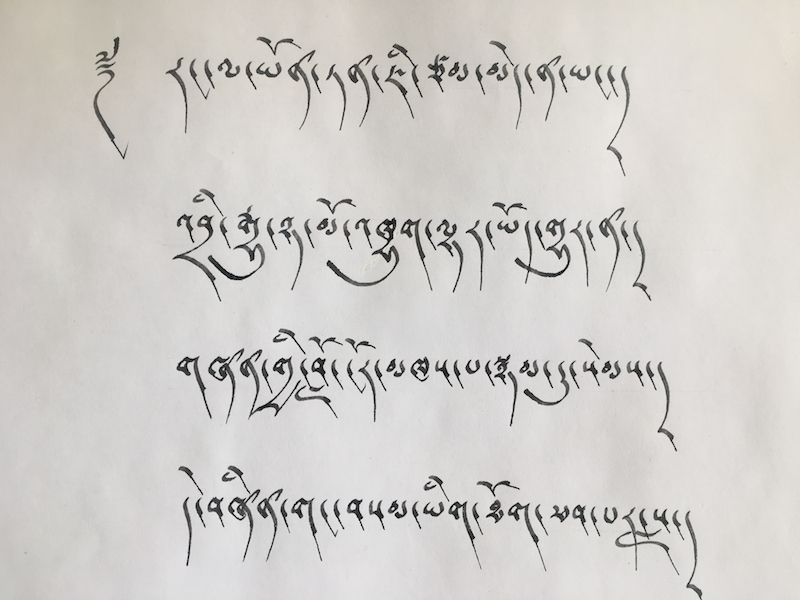Tibet has its own language, including a unique alphabet and various written forms. Tibetan calligraphy is beautiful and there are numerous Tibetan writing styles. This blog post showcases some of them.

Tibetan Buddhist nuns at Dolma Ling Nunnery in India take part in the annual Tibetan calligraphy competition. Photo courtesy of the Nuns’ Media Team.
The Tibetan alphabet has 30 characters or letters and four vowels. Like English, it is written from left to right in horizontal lines. The origins of Tibetan as a written language date back to the 7th century AD and the reign of King Songtsen Gampo. One of the king’s ministers, Thonmi Sambhota, is credited with creating the Tibetan alphabet. He and other scholars were sent by the king to India to study the art of writing with the aim of making the Buddhist teachings available to Tibetans.
Buddhism plays a central role in Tibetan culture. This is true for Tibetan writing as well. Many examples of Tibetan calligraphy come from religious texts. Most Tibetan scribes or experts in Tibetan calligraphy come from monastic backgrounds.
Here is a video of Tibetan Buddhist nuns practicing Tibetan calligraphy. Can’t see the video? Click here.
Traditionally, Tibetan nuns did not have access to the same level of education as monks. Now Tibetan nuns, such as those studying at the nunneries supported by the Tibetan Nuns Project, have the opportunity to learn their own written language and various forms of Tibetan calligraphy. This is groundbreaking because many of the nuns who escaped from Tibet and arrived in exile in India were completely illiterate on their arrival. Most of them couldn’t even write their names.

Tibetan Buddhist nuns writing on a chalkboard. The form of Tibetan script they are using is called Tsukring. Photo courtesy of Olivier Adam.
Tibetan Calligraphy
Tibetan writing may be broadly divided into two types, “headed” called Uchen and “headless” called Umeh. These two forms of Tibetan script correspond roughly to printed and cursive writing.
Uchen (U-chen)
The most common script for Tibetan writing and the one used in printed books because of its clarity is called Uchen (དབུ་ཅན།). Uchen means “with head” and this form of Tibetan writing is basically printing.
The Uchen form of Tibetan writing has heavy horizontal lines (heads) and tapering vertical lines. For Tibetan students of all ages this is the the most basic form of both handwriting and calligraphy. Students, including the Tibetan Buddhist nuns, must master this form of writing before moving on to other styles.

A Tibetan Buddhist nun at Dolma Ling Nunnery and Institute writes a calligraphy exam. She is using Uchen (དབུ་ཅན།), the headed writing which is the same style of Tibetan script used in printed books for its clarity. Photo by the Nuns’ Media Team.
Unlike English, there is not a distinction in the Tibetan alphabet between capital letters and lowercase letters. There is only the one letter form in the printed form Uchen which is more like block printing. In fact, the Uchen form of Tibetan writing is used for wood block prints and on Tibetan prayer flags.
Umeh (Umê)
Another form of Tibetan writing is called Umeh (དབུ་མེད།) or “headless” form and this encompasses a range of different styles. Umeh is essentially cursive writing in various forms that may be used for inscriptions, formal letters, and correspondence. It looks quite different to Uchen because of the lack of the horizontal lines (heads) on top of the letters.

Nuns are taught and examined on Tibetan language and Tibetan calligraphy. In this exam paper, a Tibetan Buddhist nun demonstrates her skill and knowledge of Drutsa, a form of “headless” cursive writing that is used for formal purposes. Photo by the Nuns’ Media Team.

Here are the words “Free Tibet” written in 4 styles of Tibetan calligraphy. The top is in Uchen, the printed form, followed by Tsukring, Paytsik, and Drutsa. At the bottom is the artist’s signature in Chuyig style. Photo and calligraphy by Tashi Mannox, Wikicommons.
There are many forms of Umeh writing, including:
- Drutsa འབྲུ་ཚ། An artistic form of Tibetan calligraphy that is used for official documents and titles. With its long, tapered descending lines, Drutsa is both formal and more “flamboyant” that some other scripts.
- Chuyig འཁྱུག་ཡིག། (also spelled Kyug’yig or Gyuk yig) means “fast letters” or “flowing script”. This form of cursive writing is used in day-to-day life for things such as informal handwritten notes and personal letters.

This example of Tibetan calligraphy was pinned to a classroom bulletin board at Shugsep Nunnery. It was written by a nun in the Drutsa style of Tibetan writing. It says, “Even if one is not highly learned, if your handwriting is elegant like the shape of a fish, others will think you are highly learned, and therefore it is easy to write what you think and feel!”

I deeply appreciate these “lessons” into the life and learning of the nuns. Seeing the role they play in the preservation of a culture encourages me to help as much as I am able.
Beautiful. Reflective of care, sensitivity, and compassion. Thank you for sharing.
Pingback: Tibetan caligraphy – Sagesse du Tibet
Beautiful! I’m American and I’m learning Uchen.
Excellent post. Thanks
I need umeh font for types in computer for the daily use